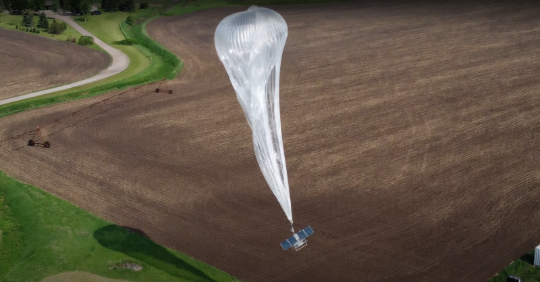In May, instead of marching at his commencement ceremony, Zachary Gaines ('23, aerospace engineering) and four fellow students were in a field outside Sioux Falls, South Dakota, watching a 100-foot-tall high-altitude balloon fill with helium. Attached to it was an updated Bronco Space Club CubeSat, Bronco Ember, designed to detect wildfires and alert fire officials.
Initially funded with $500,000 won in NASA's 2020 TechLeap Challenge, the CubeSat was designed and built by Cal Poly Pomona students led by Christian Rodriguez ('22, mechanical engineering). Its first flight was a four-hour test on a high-altitude balloon.
This four-day flight test, sponsored by NASA on an Aerostar balloon, was planned to float around Sioux Falls at 75,000 feet. Gaines, the project lead; Bryan Rivera, a electromechanical engineering technology senior; Alex Mariano, a computer science junior; Neha Khan, a computer engineering senior; and Kayla Le, a computer science senior, were there to watch the launch and conduct test fires of various sizes to see if Ember could detect and correctly identify the fires and their potential threat. Coincidentally, a local fire department was scheduled to burn a small building.
The student team had spent the months between flights upgrading the artificial intelligence, training it on thousands of additional satellite images, upgrading the software to dual processing (and to do split computing) in order to increase efficiency, and switched motors so it now drew one-third less power.
"On Ember, it was really rewarding to see the cameras move because the motors were controlled with my software," Mariano said. "It was proof that something I did made something happen in the real world."
Fate and a unique weather pattern had different plans for the flight. With stronger than usual winds pushing southwest, the balloon headed to Kansas, then through Colorado and over the Rocky Mountains to Oregon before coming down.
Gaines and Mariano tracked the balloon as it initially headed South toward Nebraska, while Rivera and Le were in a rental car trying to catch up with it. If they were lucky, they would be able to set off a smoke bomb within Ember's camera range. But with cloud cover beginning to thin in just one area, they had only one chance. In the middle of a small Nebraska road, they lit all seven of their smoke bombs.
"It was pretty high-pressure," Rivera said. "We drove so much and worked so hard just to get that image of the smoke plume."
Ultimately, the team captured 10,000 images of the smoke plume as well as the rivers, buildings, parks and even a few planes - all of which are useful for training the AI for future missions.
Prior to the May launch, Rivera spent about six months learning how to pull satellite images from a variety of satellite systems, converting them into a useable format and ultimately adding more than 1,000 images to the AI training database.
"Already [Ember] can detect a smaller fire than any current fire-detection satellite; that's a big leap," said Rivera, who is in the U.S. Marine Corps Reserves. "But, we want to improve our grand sampling distance. We saw the smoke, but it wasn't high enough quality to make the kind of educated predictions about where it's moving and how fast it's growing."
"This was the most amazing opportunity," added Rivera, who will lead the club as president in 2023-24. "On smaller group projects, at a job or in class, you're usually told what to do… [At Bronco Space] you have a conversation about big overarching goals and directions. Then you find a way to contribute." This summer Gaines and club founder Michael Pham ('23, aerospace engineering) transitioned to their new roles as research associates and will help guide Bronco Space along with club advisor and mechanical engineer lecturer Tarek Elsharhawy.



